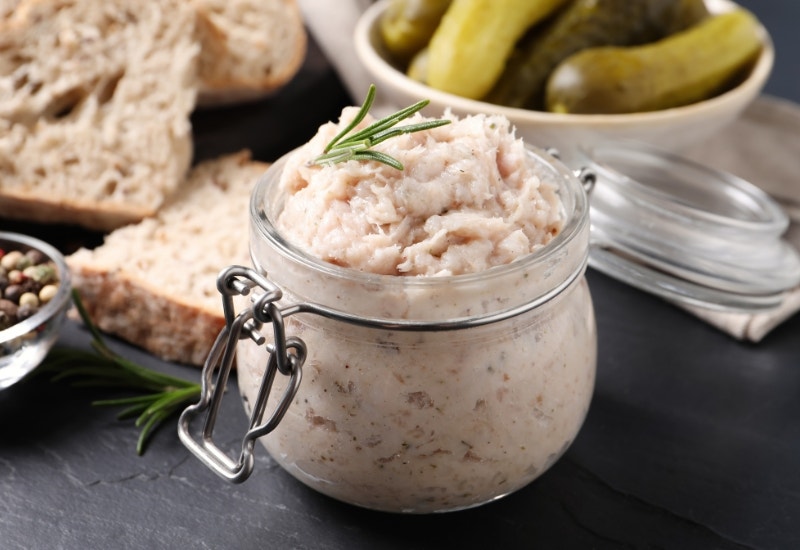Bacon Grease: A Comprehensive Guide to Saving, Storing, and Cooking

Bacon grease, often called “liquid gold,” has been a cherished ingredient in culinary traditions for generations. Its unique flavor and versatility make it a valuable component in a variety of dishes. Still, there are also health considerations to keep in mind when deciding to save and use it. Taking proper measures to collect, store, and utilize this flavorful fat has so many benefits in the kitchen.
Collecting and storing bacon grease requires a few essential steps to ensure the best quality and longest shelf life. Choosing the right container, such as a glass jar or other heat-proof container, and using appropriate techniques to strain the grease will help prevent rancidity and maintain its flavor. Monitoring the quantity and condition of the stored bacon grease ensures its safety for use in your favorite recipes. Cooking with it enhances the taste and can be a cost-effective option while providing additional nutritional value.

In addition to its culinary appeal, using bacon grease has positive environmental implications when properly disposed of, rather than pouring it down the drain. Incorporating safe handling practices and exploring creative recycling ideas contributes to the sustainability and enjoyment of this flavorful fat. As with any ingredient, understanding the alternatives, such as other animal fats and vegetable oils, is important for diversifying your culinary repertoire and making informed choices in the kitchen
Table of Contents
Why Save Bacon Grease?
Saving bacon grease provides a lot of benefits when it comes to cooking. The rich flavor that bacon fat offers elevates and enhance many dishes. Known for its savory and smoky taste, it is an excellent addition to various recipes.
One reason to save bacon grease is the unique flavor it imparts to dishes that are cooked with it. Using its drippings give meals a depth of taste that is difficult to replicate with other fats or oils. Incorporating bacon fast into a dish can result in a robust, hearty, and smoky flavor profile that is highly sought after in many cuisines.
Another benefit of saving it is the cost savings it provides. Rather than purchasing additional cooking oils or fats, utilizing bacon drippings can be a more cost-effective option. By reusing bacon fat, it allows for the repurposing of a byproduct that might otherwise go to waste.
Moreover, there are some nutritional aspects associated with bacon grease. While moderation is essential due to the saturated fat content, bacon fat contains monounsaturated fats, which provide certain health benefits. Additionally, bacon drippings are a source of vitamins and minerals, such as B vitamins, which contribute to the nutritional value of dishes where it is used.
Incorporating bacon grease into various recipes helps enrich and elevate the taste and texture of meals. Cooking with bacon fat transforms dishes to evoke a savory, smoky character synonymous with a “bacony” flavor.

Health Considerations
When deciding whether or not to save and use bacon grease in your cooking, it’s essential to consider the potential health implications. It is primarily composed of saturated fat. Saturated fat has been associated with increased levels of LDL cholesterol, which can contribute to heart disease.
However, it’s worth noting that not all saturated fats are created equal. Bacon grease contains a specific type of fatty acid called conjugated linoleic acid (CLA). Some studies suggest that CLA may have health benefits, such as reducing body fat and improving insulin sensitivity. Despite these potential benefits, it is essential to consume sources of saturated fat in moderation to maintain a balanced diet.
Another aspect to consider is cholesterol. While it is true that bacon and its grease contain cholesterol, dietary cholesterol has a limited impact on blood cholesterol levels for most people. Instead, foods high in saturated and trans fats have a more significant effect on blood cholesterol levels.

Incorporating it into your diet can also provide some nutritional value, as it contains small amounts of vitamins and minerals. However, these benefits come alongside the high levels of fat and calories, so it is crucial to use it sparingly.
Collecting and Storing Bacon Grease
How to Collect Bacon Grease Tips and Tricks
Storing bacon grease begins with collecting it. First, cook bacon as desired, then cool the fat in the pan slightly. Carefully pour the warm oil through a fine mesh strainer or a sieve lined with cheesecloth to remove solid bits. Don’t rush this step to avoid spills and prevent burns.
How Much Bacon Grease Should You Save? A Guide to Quantity
The amount of bacon grease to save depends on the frequency of use in cooking. A few tablespoons provides enough flavor for many dishes, but those who cook with it regularly may want to save more. It’s important to monitor the storage container’s capacity and only store an amount that can be used within the safe shelf life.
The Best Containers for Storing Bacon Grease
Bacon grease should be stored in an airtight container, preferably glass, like a Mason jar or similar container made for bacon drippings. Glass containers are preferred for their ability to withstand temperature changes and prevent any potentially harmful chemicals from leaching into the grease.

Straining Bacon Grease Techniques and Tools
Straining bacon grease helps remove any solid particles which can contribute to spoilage. In order to strain grease effectively, fine mesh strainers or sieves lined with cheesecloth can be used. Press the filter or cheesecloth snugly inside the mouth of the container before slowly pouring the warm grease through it.
Preventing Rancidity in Bacon Grease Storage and Shelf Life
Proper storage and handling extends the shelf life of bacon grease. Keep grease in an airtight container and store it in a cool environment. The refrigerator is ideal for maintaining quality, and the freezer can be used for long-term storage. Room temperature storage is not recommended, as it can lead to faster spoilage and rancidity.
How to Tell If Bacon Grease Has Gone Bad
To determine if bacon grease has gone bad, look for color, smell, and texture changes. Rotten bacon grease will have an off, rancid smell and might become discolored or develop mold. If any of these signs are present, it’s best to discard the grease and start fresh with a new batch. Regularly inspect stored bacon grease to ensure it remains safe to use.
Cooking with Bacon Grease
Benefits of Cooking with Bacon Grease
Cooking with bacon grease offers various advantages, such as flavor enhancement, cost savings, and nutritional value. When used in moderation, it greatly enhances the taste of dishes like eggs, potatoes, and veggies due to its savory, smoky flavor. It adds a rich, distinct seasoning to recipes like sautéed vegetables, roasted chicken, and fried bread or corn.

Using it as a cooking oil can be a cost-effective alternative to purchasing other oils or fats at the grocery store. When collected from cooked bacon and stored, it can be repurposed in various dishes instead of buying additional cooking oil or fats, leading to significant cost savings in the long run.
While it is high in saturated and trans fats, it can provide certain nutritional benefits when taken in moderate amounts. it is a source of CLA, which may help reduce body fat, grow muscles, and improve insulin resistance according to Farm Fresh For Life.
How to Render Bacon Grease
Choosing the Right Bacon
When rendering bacon grease, opt for high-quality, thick-cut bacon. This type of bacon will produce a good amount of rendered fat and impart a better flavor profile to the dishes you create.
Cooking Methods
There are several ways to cook bacon to collect the rendered grease, such as frying in a pan, baking in the oven, or even using a microwave with a bacon tray. Each method has its merits, but the key is to simmer the bacon, so it doesn’t burn and adequately renders the fat.

Straining and Storing
Once the bacon is cooked, carefully pour off the liquid grease into a heatproof container, such as a glass jar or bowl. To remove any solid meaty bits, which causes microbial growth, strain the grease using a fine mesh strainer or coffee filter, as suggested by The Washington Post.
Allow the grease to cool down before storing it in the refrigerator or freezer in an airtight container, which helps prolong its shelf life up to a month. If you have small quantities of grease, consider pouring it into an ice cube tray and freezing it for easy portioning when needed for recipes like salad dressings, sautéing hash browns, or adding a smoky touch to your favorite roasts.
Proper Disposal of Bacon Grease
Disposing of bacon grease properly is important for both the environment and the safety of your kitchen. One common method to dispose of it is to let it solidify before throwing it away. Line a pan with paper or a silicone liner, and allow it to cool and harden. Once solidified, simply scrape the fat into the trash. Another option is to pour the liquid grease into a disposable container, such as an empty soup can or plastic tub, and then throw the container in the trash once it has cooled and solidified.

Environmentally Friendly Options
Using bacon grease a second time or recycling it is a great way to reduce food waste when cooking. It can be strained into a sealable container and refrigerated for later use.
Another eco-conscious option is to transform used bacon grease into animal feed or birdseed cakes. Mix the solidified grease with seeds or feed, and distribute the mixture outdoors for animals to consume. This can also be a fun and creative family activity.
In conclusion, there are multiple methods for disposing of bacon grease responsibly. Consider reusing or recycling the grease for an environmentally friendly approach, but remember that regardless of the way you choose, it is crucial to prevent hot grease from going down the drain to avoid potential plumbing issues. Always handle fat with care to ensure a safe and clean kitchen environment.
Cleaning Up Bacon Grease Spills: Steps and Supplies
Cleaning up bacon grease spills can be a bit tricky, but with the right steps and supplies, it can be done effectively. First, remove any solid pieces of bacon or residue from the surface using a paper towel or a spatula. Then, sprinkle an absorbent material like baking soda, cornstarch, or flour over the spill to soak up the grease. Allow it to sit for a few minutes before carefully sweeping it into a dustpan or wiping it up with a cloth.

Next, use a degreasing dish soap mixed with warm water to clean the surface. Be sure to scrub thoroughly and rinse the area well to remove any remaining residue. Finally, dry the surface with a clean cloth or paper towel. For more stubborn spills, you might consider using a degreasing cleaner specifically formulated for tackling grease and grime. These are the ones we like.
Removing Bacon Grease Stains from Clothing and Fabrics: Techniques and Products
Removing bacon grease stains from clothing and fabrics can be challenging, but with the proper techniques and products, it’s possible to salvage your stained items. Start by gently scraping away any excess grease with a spoon or butter knife. Then, place a clean cloth or paper towel underneath the stain to prevent it from spreading to other areas of the fabric.
Apply a pre-treatment stain remover or a small amount of liquid dish soap to the stain, gently rubbing it into the fabric. Let the treatment sit for at least 10-15 minutes, allowing it to penetrate the grease. Next, launder the item as usual, following the care instructions on the label. Be sure to use the hottest water temperature recommended for the fabric to help break down the grease.
Before drying, check to see if the stain has been removed. If it’s still visible, repeat the pre-treatment and laundering steps. Do not place the item in the dryer until the stain is gone, as heat can set the stain and make it more difficult or impossible to remove.
Handle with Care: Cautionary Tips for Cooking with Bacon Grease
Sizzling bacon grease may seem like liquid gold, but this hot fat can wreak havoc if handled haphazardly. Take care when cooking with bacon drippings to avoid potential perils.
Scalding Splatter
Searing specks can burn bare skin when bacon grease spatters from the hissing pan. Protect yourself by wearing long sleeves, an apron, and oven mitts. Turn the exhaust fan to high to clear airborne grease.
Slick Surfaces
Spilled grease makes surfaces dangerously slick. Clean up spills immediately to avoid slips. Use paper towels to wipe up every last drop from the stove, counters, and floor. Rinse with hot soapy water.
Rancid Odors
Grease left sitting grows rancid over time, stinking up the kitchen with its foul funk. Never leave grease out on the counter. Store it covered in the fridge or freezer to prevent it from going bad.
Pipe Clogs
Bacon grease should never go down the drain. As it cools, the fat congeals into clogs. Let grease solidify before tossing it in the trash. Use paper towels to clean pans and wipe up spills.
With care, bacon grease can be a cooking treasure, adding rich flavor to veggies, eggs, and more. Follow these tips to safely handle this hot fat and avoid messy mishaps or accidents. Respect the grease, and your kitchen will stay hazard-free.
Safely Handling Hot Bacon Grease: Precautions and Best Practices
Follow these guidelines to ensure your safety when dealing with hot bacon grease.
- Always use oven mitts or thick pot holders when handling a hot bacon grease pan. This will prevent burns on your hands and allow you to maintain a secure grip on the pan.
- Never pour hot bacon grease directly into a container, especially a glass one. Instead, allow the grease to cool slightly in the pan before transferring it to a heat-resistant container such as a Mason jar.
- Use caution when straining bacon grease. Straining can be done using a coffee filter or a fine mesh strainer, but be careful not to burn yourself during the process. Consider holding the strainer with a pair of tongs to keep a safe distance from the hot grease.
- Do not leave hot bacon grease unattended on the stove; it can pose a fire hazard if it overheats. Keep an eye on the pan and remove it from the heat source as soon as you’ve finished cooking.
- Avoid splattering hot grease when cooking by using a splatter screen or a lid, especially when cooking at a high heat. This will keep the grease contained and minimize the risk of burns or messes.
Other Uses for Bacon Grease
Bacon grease can be surprisingly versatile beyond the kitchen. Its rich flavor and high-fat content make it a surprisingly useful ingredient in various applications. This section will explore some creative and sustainable ways to reuse and recycle it.
One popular and unique use of bacon grease is creating bacon-infused bourbon. To create this distinctive cocktail ingredient, you can combine it with bourbon and left to infuse, allowing the two flavors to meld together. Once the mixture achieves the desired flavor profile, it can be chilled to solidify the fat and then strained, leaving behind the bacon-infused bourbon. This infusion elevates cocktails with a smoky and savory twist.

Bacon grease can also be repurposed as a homemade lard. Traditionally, lard is made by rendering the fat from pigs. By saving up and rendering it, you can create a homemade lard that can be used in baking and cooking as a substitute for other animal fats or vegetable oils. This DIY lard can impart a rich, smoky flavor to various dishes.
In the realm of personal care, bacon grease may not seem an obvious choice. However, its high-fat content and unique properties can be harnessed to create homemade soaps and lotions. The fat in it can contribute to a moisturizing, thick lather when combined with other ingredients like essential oils and natural scents. Soap makers can create unique products with an eco-friendly twist by repurposing it.
If none of the above uses for bacon grease appeal to you, consider using it as a supplement to your garden. It can be used as a natural and organic barrier to protect your plants from pests like slugs and snails. When applied around the base of plants, the grease can deter these critters, ensuring your garden thrives.
Alternatives to Bacon Grease
While bacon grease can add immense flavor to your cooking, there are times when it may not be available or suitable due to dietary restrictions or personal preferences. In such cases, consider the following alternatives to achieve a similar effect in your dishes:

Other Animal Fats
In Southern cooking, animal fats have often been used to enhance flavor in various dishes. Some suitable alternatives to bacon grease include:
- Lard: The rendered fat from pork, lard is a versatile fat suitable for frying, sautéing, and baking. It can be found in your local grocery store or created at home by rendering pork fat.
- Tallow: Extracted from beef or mutton, tallow is another excellent option for frying and sautéing, offering a rich, meaty flavor.
Both of these options can be stored in a Mason jar in your refrigerator or pantry, just like bacon grease.
Vegetable Oils
If you’re seeking non-animal-based options, several vegetable oils can substitute for bacon grease:
- Olive oil: An ideal choice for sautéing, it is a healthy fat rich in monounsaturated fats and antioxidants. However, avoid using extra-virgin olive oil for high-temperature cooking, as it has a lower smoke point.
- Canola oil: An affordable and versatile oil, suitable for a variety of cooking techniques, from frying to baking. It has a neutral taste and a high smoke point.
Butter and Margarine
Butter and margarine can be used as alternatives in recipes that call for bacon grease, with some essential differences to keep in mind:
- Butter: With its rich flavor, butter can be a suitable alternative for baking and frying. However, be cautious when cooking over high heat, as butter has a lower smoke point and can burn easily.
- Margarine: A plant-based alternative to butter, it is suitable for frying, sautéing, and baking. Look for varieties with a higher fat content (at least 80%) for better performance in cooking.
When substituting any of the above alternatives, be mindful of how they may affect your dish’s final flavor and texture. Also, always practice safe handling when dealing with hot fats and oils to avoid spills or burns.
Conclusion
In this article, we explored the reasons to save bacon grease, its health considerations, and effective methods for collecting, storing, and cooking with it. We also discussed proper disposal, clean-up techniques, safe handling practices, alternative fat sources, and creative uses for it. Notably, we discovered that the coffee filter and fine mesh sieve are useful tools for straining it, and the importance of using appropriate storage containers to prevent rancidity.

When handled mindfully, bacon grease can be a valuable resource in the kitchen, offering flavor enhancement, cost savings, and nutritional benefits. It’s essential, however, to ensure proper storage and use and the responsible disposal of excess grease. Additionally, it’s crucial to be aware of health considerations and utilize it in moderation as part of a balanced diet.
For those interested in exploring other fat sources, alternatives such as vegetable oils, butter, margarine, and other animal fats can offer a variety of culinary advantages. It’s also worth considering creative uses for it, such as in DIY projects or as a component of a sandwich for added flavor.
In conclusion, preserving and utilizing bacon grease can be both sustainable and beneficial when managed effectively. By following the guidance shared in this article, readers can confidently navigate the process and enjoy the benefits of it.







Comments are closed.